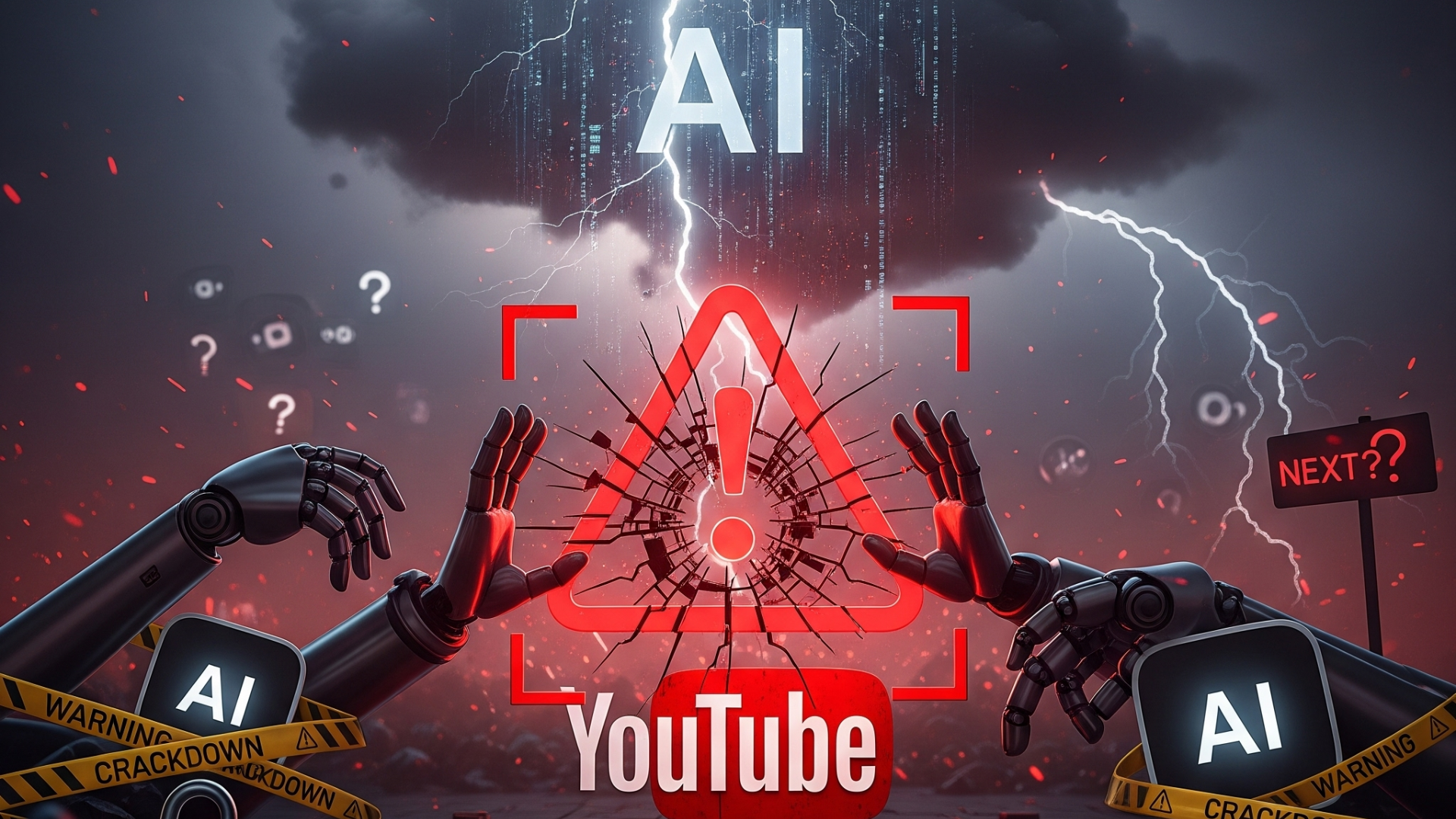
The advent of artificial intelligence has transformed content production, with unprecedented scale and velocity. But the revolution has also created its own set of problems, chief among them for sites such as YouTube, which are dependent on creator uniqueness and real engagement. As of July 15, 2025, YouTube is making wholesale changes to its monetization policies, aimed specifically at “mass-produced, repetitive, or inauthentic” content, a category that encompasses much of purely AI-generated video.
This is not an outright prohibition upon AI. YouTube has explicitly stated that AI technology can still be used to enhance content, but the focus now is on human value, original content, and authenticity. So, if your AI kingdom of video is having a shake, let’s get down to why YouTube is doing this and explore other means by which you can monetize off of your AI-generated content.
Why YouTube Is Cracking Down on “AI Slop” Content

YouTube’s decision to crack down on monetization policies for AI content is a reaction to several key problems:
1. Deteriorated Content Quality and View Experience: As low-effort, mass-produced AI content has become a reality, there is a proliferation of replicate, unoriginal videos. Such “AI slop,” as some refer to it, has the potential to bring down the overall view experience, leading to more bounce rates and less engagement. YouTube viewers visit the site to view distinctive, interesting, and occasionally even human-created content, and a string of almost identical, AI-generated listicles or generic voiceovers over stock footage simply will not cut it.
2. Advertiser Concerns: Advertisers are increasingly wary of associating with indistinct branded content that is also poor, unauthentic, or even false. An advertising hub, brimming with AI-generated video that lacks any sense of the human touch, can spook advertisers and adversely affect YouTube’s primary revenue stream.
3. Ensuring Authenticity and Trust: YouTube has always envisioned reasonably compensating creators based on original, genuine content creation. When AI can generate potential infinite variations of content (where humans are involved on a minimal level), it’s cheapening true creative/assign value, and could possibly ruin any trust built between the platform itself, creators, and the audience. The platform has an obligation to better understand the validity of their creators in the Partner Program and whether that creator is impersonating someone or artificially inflating their engagement.
4. Fighting Misinformation and Manipulative Techniques. Not solely an AI problem, AI content can be easily manipulated to create realistic but deceptive stories, impersonations, or misleading facts. By identifying “inauthentic content,” YouTube aims to reduce the chance of such offending content being monetized and shared extensively.
5. Value-Added AI vs. Pure Automation: YouTube does not object to AI. They’re investing in AI creation themselves. The distinction is in AI application. If AI is pure automation of content creation with minimal human transformation, commentary, analysis, or creative narrative, it will probably be demonetized. If an AI voice offers genuine insight over fresh, human-created footage, it stands a chance.
The “New Normal” of YouTube AI Content

For all those interested in profiting from AI-generated content on YouTube, the takeaway is human value addition. That is to say:
- Substantial Transformation: If you borrow or reuse content using AI, you need to substantially transform it so that it is your own. Using filters or changing the speed won’t meet the test.
- Original Commentary and Insight: If videos are filled with AI voices or stock footage, you have to provide original scripts, sharp commentary, or new insights.
- Entertainment or Educational Purpose: Your content should be developed for entertainment or educational purposes for the viewers and not for the sake of earning views through repetition.
- Transparency (and Future Implications): Although not yet associated with monetization, YouTube already has the requirement for creators to indicate when content is “meaningfully altered or synthetically generated” if realistic. Failure to indicate regularly could potentially have future repercussions, e.g., suspension from the YouTube Partner Program.
Additional Sites for Monetizing AI Content
With YouTube’s constant shifts in strategy, the market for AI content and tools to create it continues to grow. Below are some additional platforms and avenues where you might have opportunities to monetize your AI work:
1. Stock Content Marketplaces (Images, Videos, Audio)

If your AI produces high-quality visual material, stock shots, or audio, then these are where you want to be.
Wirestock: The site allows you to sell AI-created images, videos, illustrations, 3D, and AI art on different leading stock marketplaces like Adobe Stock, Getty Images, Shutterstock, and Envato from a single panel. They also offer opportunities to earn money from custom AI training datasets.
Adobe Stock: A premium platform to market creative assets, including AI-created images and vectors, as long as they meet quality and ethical standards.
Shutterstock: Similar to Adobe Stock, Shutterstock also licenses a wide range of visual content, such as AI art.
Getty Images: This premium stock content provider will also accept AI-generated photos, usually paying at a premium rate.
2. Short-Form Video Platforms

TikTok: With the Creator Fund (now Creator Rewards Program, with potentially better pay), TikTok compensates creators based on the success of the videos. Affiliate marketing and sponsorships by brands are also possible. Virality and new engagement is the goal here, though AI-enabled.
Reels on Instagram: Like TikTok, Reels may provide monetization through the Creator Marketplace, branded partnerships, and potentially even direct payment by Instagram as their monetization features develop.
Facebook Watch: Facebook also offers monetization via in-stream ads and subscriptions for eligible creators. Its massive user base can provide good reach.
X (ex-Twitter) Video: X’s real-time conversation emphasis can make it an excellent platform for short, impactful AI-created videos that generate conversation. Monetization frameworks are still being built out but involve ad revenue sharing and subscription.
3. Course Content & Learning Platforms

If your AI is able to generate learning materials, tutorials, or courseware (such as scripts, visual aids for explanation):
Udemy: An online learning platform where you can host and sell video courses. If your AI is assisting you in creating unique and useful learning content, this is an apt option.
Udemy: https://www.udemy.com/
Thinkific / Uscreen: They allow you to host and sell your own online courses and membership websites. They give you more control of pricing and content and are best suited to niche AI-created learning material.
Thinkfic: https://www.thinkific.com/
Uscreen: https://www.uscreen.tv/
4. Fan-Funding & Membership Sites

For artists who wish to establish a constituency of fans for their AI-created work and give insiders access:
Patreon: Allows you to set up membership tiers and offer exclusive content to your patrons. This is perfect for keeping in touch with your fans and getting continuous funding for your AI work and activities.
Patreon: https://www.patreon.com/
Ko-fi: Simple page for fans to “buy you a coffee” or subscribe for ongoing support.
Ko-fi: https://ko-fi.com/
5. Web3 & Decentralized Platforms

These platforms tend to be creator-owned and offer crypto rewards, which is in the spirit of innovation for AI:
DTube: Blockchain-based video-sharing site that motivates content creators by offering them incentives in cryptocurrencies. It promotes content freedom and transparency.
URL: https://d.tube/
BitChute: An alternative video sharing website with a focus on freedom of speech and reduced censorship, but with a specialized audience.
URL: https://www.bitchute.com/
6. AI-Specific Monetization Solutions

New platforms are specifically designed for monetization of AI products and content:
RevenueEngine.ai: It is centered around making money from generative AI products, plugins, and apps. It makes money from “shoppable” references in AI-created content (e.g., product recommendations or “best of” lists) by making them earnings-generating affiliate links. This is extremely applicable if your AI content is giving actionable tips or recommendations.
URL: https://ai.wildfire-corp.com/ai-revenueengine
Monetag: An AI-powered platform that allows publishers to monetize traffic through various ad types and optimized CPM rates that are most suitable for AI-generated articles or content-based websites or blogs.
URL: https://monetag.com/
The Future is Shared: Human and AI Together
While the new policies of YouTube may appear to be restrictive to most, they indicate a significant trend: the future of content that can be monetized is a collaborative harmony between human creativity and AI efficiency. Pure automated content without value addition will be a race to the bottom.
To survive in this new world, AI content creators must prioritize:
Niche Specialization: Identify niche areas where AI can actually supplement or create original content dealing with a problem or appealing to a specific reader.
Quality over Quantity: Focus on developing excellent, informative, and engaging content, even if it is synthetic, rather than bombarding sites with copycat content.
Human Touch: Bring your own thoughts, editorial decisions, and feel to your AI-generated content.
Diversification: Don’t tie yourself down to just one approach. Try various pathways and monetization methods to develop a more robust income adventure.
The era of AI content is still new. The adaptability to changing platforms, awareness of ethical issues, and ongoing innovation will be the hallmark of sustainability.



















hi